Vehicle crime is on the rise again, making the need for good motorhome security more important than ever. Despite dropping in the 2010s, the combination of an economic downturn and a shortage of spare parts thanks to supply chain issues has seen the figures start to increase. Both theft from vehicles and theft of the vehicle itself are rising.
After buying the best motorhome or camper van, you’re going to want to do everything you can to protect your home-on-wheels. So what can you do to prevent your ‘van from becoming yet another statistic?
In this guide, I’m going to be taking a look at the basics you can do to secure your motorhome, as well as the security accessories that will help, such as the best motorhome wheel clamp. You also need to know how criminals operate, so you can understand how to combat them most effectively.
To get an idea of the scale of the problem, we obtained data from the Office for National Statistics for the last complete year, 2024. The results cover 2014 to 2024 and detail the nature of vehicle theft.
In compiling this information, the Government is trying to understand the way thieves operate. It makes for very interesting reading and there is a lot to learn from it. So let’s dive in – and if you’re looking for more tips, don’t miss my guide to what you can do to extend the life of your motorhome’s leisure battery.
Motorhome and campervan security: what you need to know
How thieves work
The vast majority of thefts happen between midnight and 6am during midweek. Most are from the home location of the vehicle and by far the most common entry point is via an unlocked door, followed by window breakage and then forcing the locks.
Since 2022, one recent spike in car crime has been from the introduction of keyless entry. If you can enter your ’van without removing the keys from your person or a bag, and you don’t have to press a button on the fob to unlock the doors, that’s keyless entry.
A starter button is another clue to a keyless entry vehicle and, while most leisure vehicles do not have keyless entry, it is available on many models.
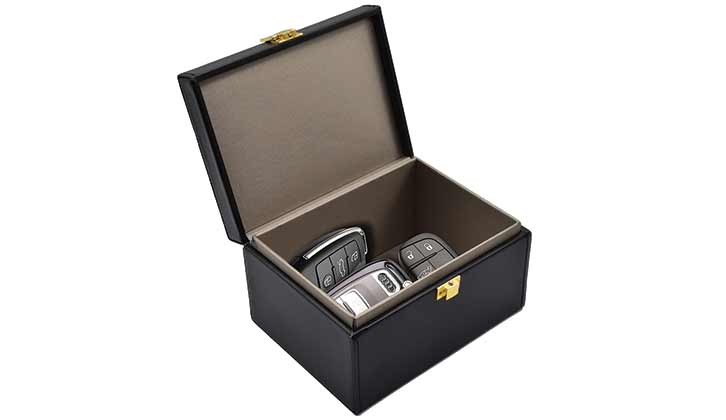
Some thefts also involve stealing the original keys (known as Hanoi burglary after the first police operation targeting it by West Yorkshire Police), or having duplicates made based on the vehicle’s chassis number and registration plate. These are in the minority, though, and generally used by professional thieves.
Of vehicles stolen, roughly a third are never found and such vehicles are often broken up for parts (this affects cars more than ’vans).
Equally, the vehicle’s diagnostic port (aka the OBD port) can be used by the thieves once they’re inside the ’van. This plug is used by garages to diagnose your vehicle when it’s in for repair and provides a direct link to the ECU. It is all encrypted, but thieves (and garages) can fairly easily gain access to the data.
If you think the criminals only target new vehicles and will ignore older motorhomes, you’d be wrong – the age spread of vehicles stolen ranges from brand-new to 20 years old. If they see an easy target, they take it.
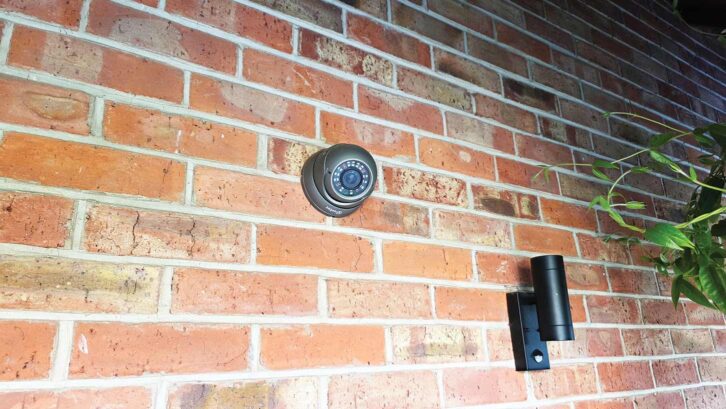
Most thieves are not professionals, but opportunists who spot something they like about your vehicle – a quarter of all thefts are from unlocked vehicles. Their favourite targets from inside a vehicle are handbags, wallets, phones and laptops. These account for 50% of all vehicle crime. Smaller items of high value that are easy to carry and conceal are what they’re after.
The thieves’ second most common target is stealing items from the vehicle body itself, such as catalytic converters and upgraded wheels. The latter is less popular, owing to the bulk and effort involved – cats are an easier win and you can fit more of them in a vehicle over a night’s work.
Where you live has a direct effect on the level of theft, according to the DVLA. Big cities typically suffer the largest incidence of crime, so London tops the chart, followed by Birmingham and then, some way behind, Manchester. According to alarm manufacturer ADT, the lowest rates of crime are recorded in Anglesey, North Wales, a place that we also consider to be one of the best seaside destinations to visit.
It’s not just the money
As well as the financial loss involved, theft of anything can also have an emotional impact on victims, which ranges from anger and annoyance to feeling vulnerable and frightened.
Many theft victims struggle to sleep afterwards because they are fearful of another incident. After buying a motorhome, there’s an even greater feeling of invasion and insecurity.
So anything that you can do to avoid becoming a victim in the first place has to be a positive thing. You can reduce the risk of theft with some simple steps.
Basic action plans to protect your motorhome and campervan
Before you start spending money on the various campervan and motorhome security devices, you need to tackle the basics. This will mean making sure you’re carrying out no motorhome mistakes when it comes to safeguarding your vehicle – for instance, ensuring each and every cab door, habitation door, window, rooflight and sunroof is properly shut and secured.
The same goes for your house – make sure keys, wallets and purses are kept well away from windows and doors (especially the front door if you have a letterbox slot) and that all downstairs windows and doors are kept shut. Stealing car keys is by far the easiest way for a thief to bag your vehicle.
If you dump your keys in a pot near the front door (or hang them close by), you need to pay close attention to their placement – if you can see the keyfob from a window or by opening your letterbox from the outside and peering in, you must move them to a safer spot.
Inside a drawer or stair cupboard, or anywhere that is immune to being ‘fished’ through the letterbox with a long-pole and hook is what’s needed.
Keyless entry fobs present their own challenges. They work by broadcasting a coded radio frequency to your ’van. This can be detected by thieves and amplified away from the house, using a relay box. This then fools the vehicle into thinking the keyfob is next to it, unlocking the doors and allowing the vehicle to be started and driven away.

While some modern vehicles put the fob to sleep after remaining immobile for a period of time, not all do this. And thieves only need a few seconds to have your vehicle away with a relay box. So you ideally need to move the keys well away from the front door of your house (or wherever you enter the property) and as far away from the vehicle as possible.
However, radio waves travel through walls, so a better option is to use an RFID holder that blocks the radio signal. These can be bought cheaply online in the form of pouches or boxes. Either is fine. If you have a keyless entry vehicle, it’s wise to buy one.
Park the vehicle with the wheels turned into an obstacle (like the side of your house, a fence or drive) and make sure no valuables are left inside.
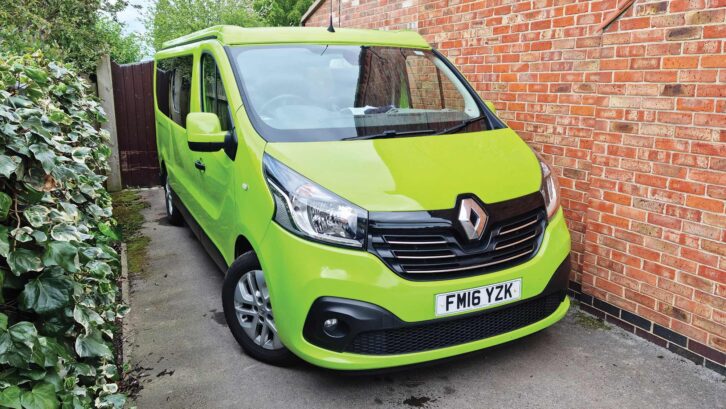
Some people like to leave an empty glovebox open, to show thieves there’s nothing inside, or you could pull all the windows shut or fit a cover (if you have one). Few thieves will want the hassle of removing a cover on the off chance that valuables are within, but equally, they can be a disadvantage in the case of catalytic converter theft, because they hide the thief from view.
Some people like to cover up their number plates and the chassis number fitted to the base of the windscreen on many vehicles. This isn’t a bad idea, as it does prevent thieves getting a key cut directly from the manufacturers. It is possible for unscrupulous people to obtain key information directly from the makers and then use an original key-cutting machine to make new keys and program a duplicate keyfob. But this is uncommon and strictly the preserve of the professional thief.
The importance of insurance
Channel 4 broadcasts some excellent shows about vehicle crime and from following professional gangs of thieves to tracking them down and revealing their tactics, there is a lot to learn from these programmes.
The professional thieves are highly organised and parts of criminal gangs operating across Europe. They will target a specific vehicle – they are often stolen to order – and then do whatever it takes to obtain it.
Alarms and motorhome trackers will not stop them, because many have the technical ability to disarm them and often store them in shipping containers protected by radio jamming devices that disrupt the signal from trackers.
On one TV show, an Audi was stolen and its path followed by the tracking device. Three weeks later, the wiring loom – with the tracker still active – was found in a scrapyard in eastern Europe. The rest of the vehicle was never recovered.
The point is this: no matter what security devices you fit, they won’t prevent a determined professional from stealing your vehicle.
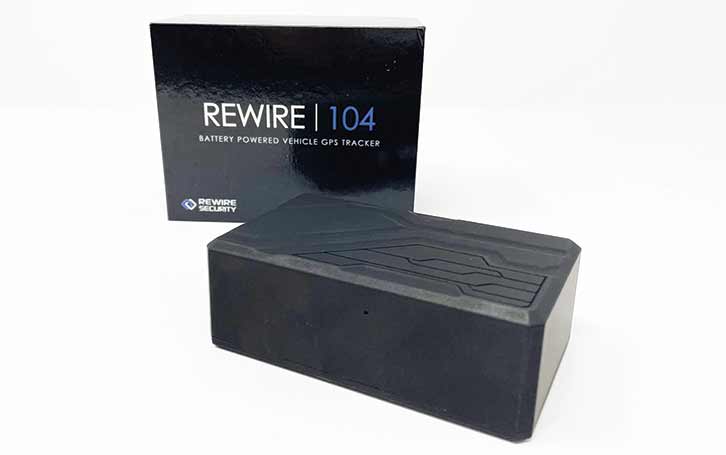
The police and security firms are forever engaged in firefighting the determined opposition, while the criminals are forever mutating with new forms of attack.
Theft of the motorhome itself forms the minority of incidents. To give you an idea of scale, about 4000 caravans, motorhomes and campers are stolen each year, according to the NCC.
An estimated 1.1 million leisure vehicles are in use in the UK, making this risk of outright theft less than 0.4%. But it’s not zero and is only an average – the risk is higher in big cities.
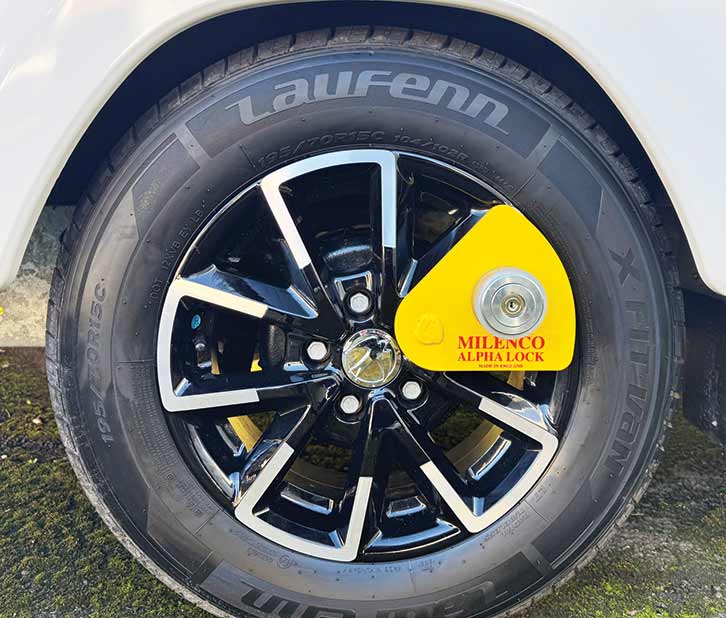
Most thefts, the vast majority, involve objects in or on the vehicle itself.
Your best protection is insurance from a reputable provider. Ensure you have good cover and follow the firm’s advice to the letter.
Declare modifications in full and make sure you fit their recommended security system for your motorhome if one is required.
The motorhome security accessories and gadgets to consider
Electronic devices
So, after choosing the right motorhome, what can you do to protect it? My first recommendation is to not solely rely on the factory-fitted motorhome security systems, as these often tend to be installed in the same places by leisure vehicle manufacturers. Thieves are wise to this and may know how to disable the security device.
Instead, focus on an aftermarket security system approved by Thatcham (the test centre funded by UK insurers) and your insurance provider. It’s no use spending several hundred pounds on a non-approved security device.
Alarms can be somewhat polarising – sometimes it feels as though the only people who pay attention to a vehicle alarm are the original owners.
If you’re away from the vehicle or out of earshot, few passersby will want to intervene. Would you risk injury to save someone else’s property? Again, insurance is the best defence here.
Trackers are much better than alarms – so long as they are monitored for 24 hours a day and an independent team will take action when unauthorised movement is detected.
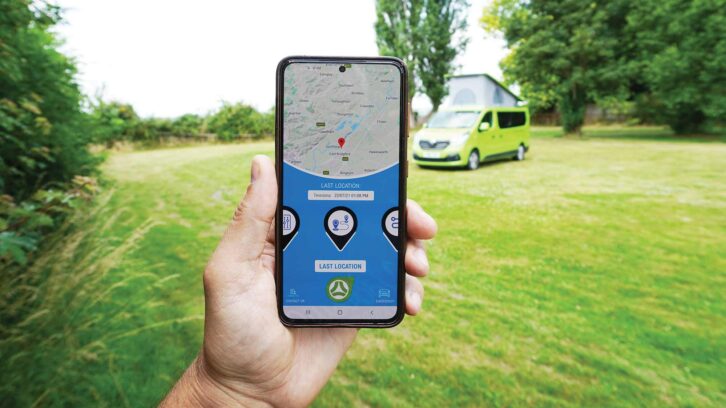
There is a much higher chance of recovering the vehicle with a tracker fitted if prompt action is taken, but make sure you only fit one approved by your insurance firm (and ideally the police). It’s wise to have your phone next to your bed during the peak crime hours of midnight to 6am, so you can be alerted by the monitoring company in the event of theft.
Some trackers also link to ultra-loud internal alarms that can make things difficult for any thief inside the vehicle (although ear defenders and earplugs exist, so this won’t deter a pro).
Look for trackers that are Thatcham security approved and make sure it is one that is also recognised by your insurer.
Trackers also have the benefit of not being intrusive to the user. Thanks to geo-fences (which are owner set – if the vehicle moves out of a specified area, you get an alert on your phone) and remote alerts, they are very much a fit-and-forget item that won’t get in the way of the vehicle’s ease of use.
For the same reason, we would also recommend an OBD port cover. These compact lockable devices fit over the diagnostic port of your vehicle and prevent a thief from simply plugging a device into your ECU and remote starting it. Just make sure you know where the key is when your vehicle is due for a service – the garage will definitely need access to it!
CRiS registration
The NCC runs the Caravan Registration and Identification Scheme and many new tourers are registered on it by the manufacturers.
You can register any type of leisure vehicle on this scheme (including motorhomes and campervans) and it’s well worth doing. It costs £20.95.
They also offer the VIN CHIP system, which consists of several RFID chips. These clever little chips do not need a battery to operate (so they work forever) and host unique information about your vehicle’s VIN that can be read by a remote device, to enable your vehicle to be easily identified by the recovery team from a distance away. The chips can even be detected when they’re on the road.
The basic VIN CHIP package of three RFID chips together with window stickers costs £49.99. Spend a little more and the VIN CHIP kits include extra RFID chips and things like micro dots, which encode your chassis number details on tiny dots that are sprinkled around your vehicle.
These dots can be used to identify your vehicle and are impossible to see with the naked eye. They have deterrent value, are low cost and are highly effective in vehicle recovery. They also work abroad.
Mechanical devices
There is something of a resurgence in old fashioned mechanical deterrent devices, but again, you need to pick ones that actually work well, rather than those that are marketed the best.
Entry to most motorhomes is by forcing a lock, so the first weak points – particularly on coachbuilts, A-class motorhomes and some large van conversions – are the habitation windows.
Fitting additional locks to the plastic window latches and habitation door handle can be a good idea. Lots of firms sell these products and they’re very easy for any competent DIYer to fit.
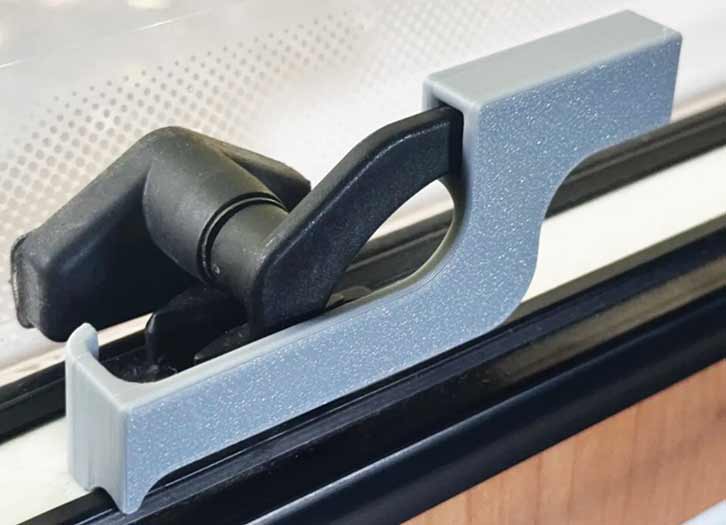
Certain vans are also prone to cab door lock attacks, so it’s also worth adding deadlocks to their doors. Thieves don’t want to make too much noise in the middle of the night, so often prefer to whack a screwdriver into metal, rather than have the louder sound of breaking a window.
Steering wheel bars are less effective, so save your money and instead opt for a steering wheel shield that covers the entire wheel. This should also protect the airbag (another lucrative item on the secondhand parts market).
However, they’re only as strong as the lock that is fitted to them and they won’t stop a professional thief. They’re also quite bulky to store – but do offer good deterrent value. Look for Sold Secure rated products that have the highest Diamond or Gold ratings.
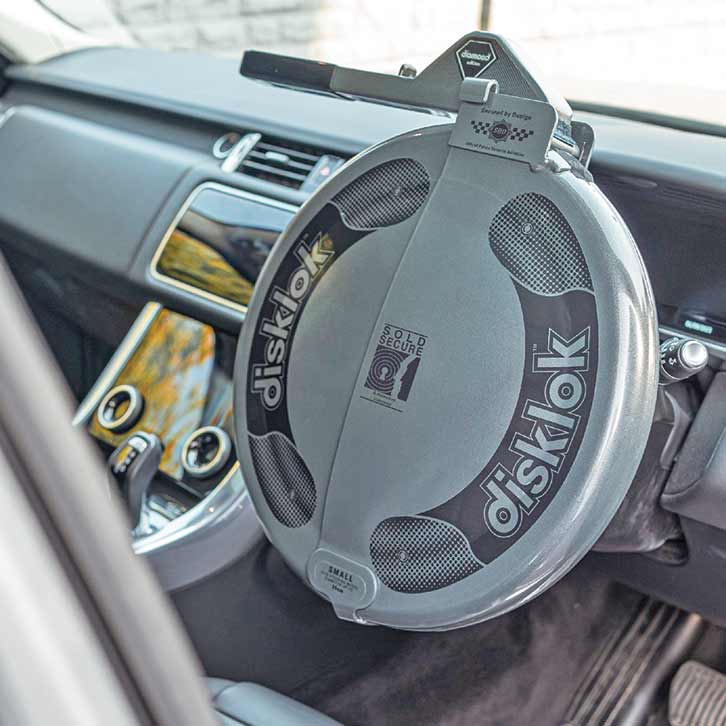
Pedal locks are another form of cab security that can work well, although they are less visually obvious than the steering wheel lock, and fitting them will involve some grubbing about in the vehicle’s footwell.
Probably the most effective visual deterrents are the best motorhome wheel clamps and security posts. The latter is the most complicated to install, as it will involve digging a massive hole, filling it with concrete and letting it set.
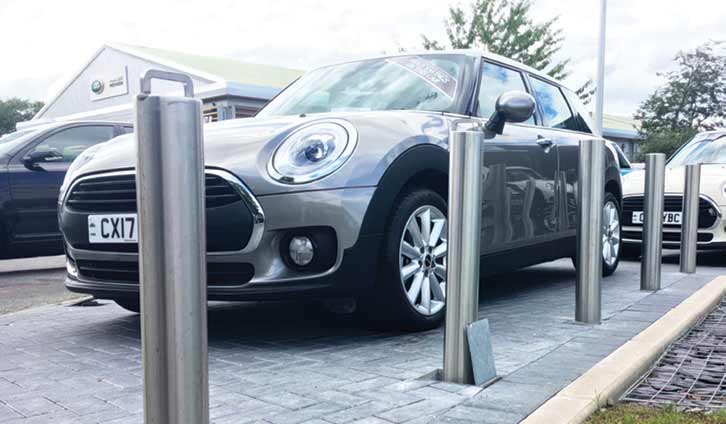
Wheel clamps are designed to fit on certain diameters and widths of wheels, so the first step is to measure the wheels fitted to your motorhome.
Although wheel clamps (and steering wheel/pedal box clamps) have the advantage that you can take them with you on tour, in reality, most are a bit fiddly to fit and bulky to store.
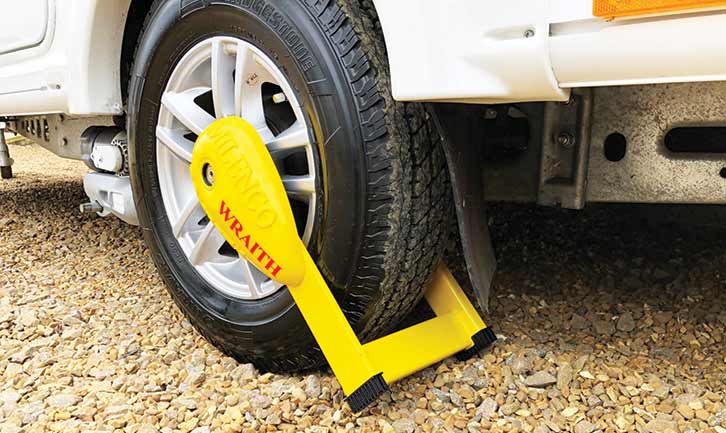
For many people, a wheel clamp can detract from your holiday time and in any case, don’t forget that the most common place for your vehicle to be stolen from is outside your home.
With any security device that you fit on your vehicle, there is a compromise to be made between efficacy and how hard it is to install and remove.
Making your vehicle like Fort Knox with 25 mechanical security devices is all well and good, but if it puts you off ever going on holiday again, that rather defeats the object.
So fit a level of extra security that you’ll be comfortable with, resign yourself to the fact that you’ll never stop a determined pro, and make sure you invest in good insurance that fully covers all contents. Also, check that insurance to see whether security devices must be fitted in order to validate the cover.
The verdict on motorhome and campervan security
It’s easy to get hung up about vehicle theft, but the reality is that theft of the whole leisure vehicle is still low (only 0.4%) and you’re best protected by high-quality insurance cover.
Add a mechanical security device for extra peace of mind, but don’t buy anything too fiddly to use.
Equally, make sure you never leave anything on show and lock all those doors, windows and rooflights.
Don’t miss what I had to say about motorhome warranties either; in these financially challenged times, it has never been more important to have a good one.
If you’ve enjoyed reading this article, why not get the latest news, reviews and features delivered direct to your door or inbox every month. Take advantage of our brilliant Practical Motorhome magazine SUBSCRIBERS’ OFFER and SIGN UP TO OUR NEWSLETTER for regular weekly updates on all things motorhome related.
Leave a Reply